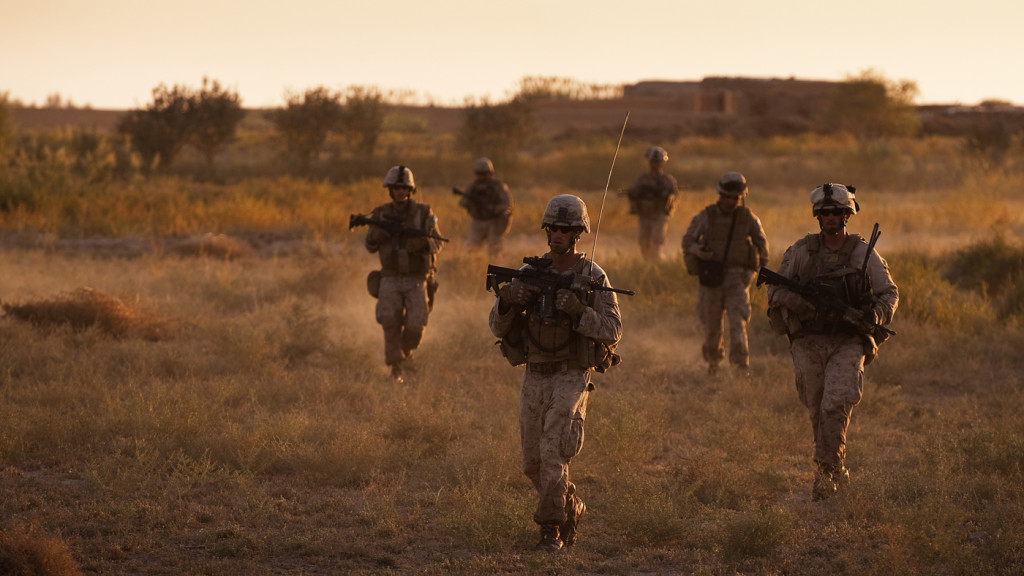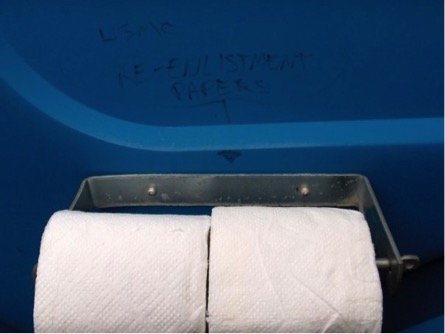The VA and What Veterans Owe Each Other

Many years ago I saw a faint black marker scrawl above a roll of toilet paper in a porta-john and the memory of that has amused me ever since. It was, like the best combat graffiti, brutally appropriate and thoroughly ironic:

Brutally appropriate because earlier in the evening my Humvee had been blown up by an improvised explosive device outside of Fallujah and I was now defecating blood. Thoroughly ironic because after being medevac’d back to base I pleaded with the captain to let me go on our next patrol, telling him I was fine. I even believed it.
My symptoms continued after redeploying home, and later stateside testing was inconclusive. I stubbornly avoided medical assistance until my wife insisted that the Department of Veterans Affairs (VA) take a look at my ongoing problem. After a colonoscopy, the doctors told me I was fine, but something I overheard from a fellow patient was not.
The doctor asked the patient – also there for a colonoscopy – if he had taken his prescription: two gallons of a nauseating elixir that causes a thoroughly violent evacuation of the bowels and intestine. Merely one gallon of the stuff kept me on the toilet the entire night. My fellow veteran patient, 40-something, rather cavalierly told his doctor and nurse that he had not bothered to finish even half of the first gallon.
Before receiving my colonoscopy at the VA hospital, I had to first schedule an hour-long pre-surgery class dedicated to explaining, with pictures, the necessity of drinking all the prescribed solution. Failure to strictly adhere to preparations would render the procedure worthless because polyps or blood cannot be seen through the unemptied intestine.
During the class, the nurse had told tales of veteran patients showing up the day of their colonoscopy eating cheeseburgers and drinking Kool-Aid (the red dye inhibits proper diagnosis). Another nurse recalled a recent week with 40 scheduled colonoscopies, each requiring a surgical room, a doctor, and a lab technician. Four patients did not follow cleansing instructions and a further 10 veterans had either cancelled on short notice or did not bother to cancel at all, robbing other veterans of an opportunity to receive needed care.
And it made me wonder: How many of those who have served are needlessly delayed medical treatment because of the apathy of other veterans?
VA has a no-show appointment rate of 13 percent, double the typical average of private medical practices in the United States. From July 2014 through June 2015 (the latest month for which data is available) that means that veterans no-showed more than 8 million appointments. Yet in the wake of last year’s veteran patient scheduling scandal, front-line staff members reported that a “lack of provider slots” was the single highest scored barrier to providing veterans timely access to care.
Perceptions of veterans have been understandably positive in the post 9/11 era, but public empathy is no excuse for veteran apathy. Recent scandals at the VA, highlighting many areas where the VA can improve, likewise provide no excuse of this apathy. The responsibility the VA has to those that have borne the battle does not supersede the responsibility that veterans owe each other.
Veteran patient apathy is partially an artifact of how military and veterans’ health care are structured and transitioned. In private health care, the patient is the customer to be treated and billed. In the military, the primary customer is the patient’s command and the cost of treatment is viewed as a function of military readiness. Understanding this, the military chain of command and the Uniformed Code of Military Justice enforce compliance with, and obedience to, medical orders.
When the soldier becomes a veteran, these distinctions change. The patient becomes the primary customer. The chain of command ceases to exist. In a heavily subsidized health care regime, this newfound freedom can exacerbate blasé attitudes about the importance of following necessary protocols. By not fully taking his prescribed cleansing solution, the veteran patient that I overheard wasted a colonoscopy appointment for himself and others. No bother, as VA doctors will likely schedule another one for him. If he should unfortunately be diagnosed with preventable colon cancer, the VA will even enthusiastically treat and care for him. But I would forgive his caregivers for wondering why they strive to better serve veterans that in many cases will not better serve themselves.
The VA has nine million veterans enrolled in its health care system. The percentage of veterans receiving disability compensation has doubled since 2001, and the average degree of those disabilities has risen by nearly 50 percent. Tellingly, three-fifths of all Iraq and Afghanistan veterans have used VA health care since 2001.
Despite this unprecedented utilization, the VA regularly bests all American health care systems in terms of average patient satisfaction. Americans neither know nor believe this. Still, whether it is the annual VA Survey of Enrollees or the Hospital Consumer Assessment of Healthcare Providers and Systems (HCAHPS), the VA regularly wins out over the competition. It does this despite treating an increasing number of veterans with combat injuries requiring specialized care. Novelty and necessity have demanded innovation: VA researchers and doctors in recent years have revolutionized prosthetics and created the nicotine patch for smoking cessation. VA personnel before them developed the first pacemaker and conducted the first liver transplant. There is good in the VA and its employees despite the refusal of many to acknowledge it.
These triumphs, however, should not overshadow areas where the VA can improve.
Sixty percent of the VA’s medical facilities are more than 50 years old, and over 1,000 were built before World War II – many to treat veterans that have long since moved elsewhere. Additional medical facilities for growing populations such as female veterans are needed in an era where capital construction costs have exploded.
The VA has more than 320,000 employees, more than a third of them veterans with honorable service, but like most other federal agencies, lacks the true freedom to quickly hire personnel and match existing talent with evolving requirements in a fluid environment. From my experience at the Washington VA Medical Center, countless VA employees are excellent, many are great, some are good, and a few are not. All should strive to test the limits that the very best of their abilities allow, and many do.
There are 10,000 senior and mid-level managers at the VA, many of whom were hired based on their superior performance in previous non-management roles. This is particularly common in military-related health professions where leaders are often promoted on the basis of clinical excellence as opposed to management potential and experience. Many VA managers can overcome this leadership challenge through training that identifies, teaches, and replicates the best practices of VA’s highest performing managers.
The VA is building more facilities and increasing its workforce to meet this unprecedented utilization. VA needs to better train its managers, and should. VA needs to be enabled to better use its talent, and can. VA leadership knows these challenges and is implementing the largest transformation in the organization’s history to address these challenges with the goal of improving the lives of the veterans it serves.
But all the resources in the world will make little difference if we refuse to acknowledge that veterans have a role to play, too. Is that obstinate 40-something I overheard one of VA’s highly satisfied patients? Maybe. Does this matter? Probably not. A highly satisfied patient can be actively disengaged in his health care decisions and responsibilities, and this meaningful distinction matters far beyond his personal satisfaction. Structural reforms alone can only accomplish so much.
Often in the service did I witness acts of self-inflicted personal neglect, many of them my own. Seldom though did I or my fellow Marines fail to seriously reflect upon how our individual actions may harm others. No better friend, no worse enemy.
I asked the captain to go back out on that next patrol because I did not want to shortchange my brothers. They needed me and I them.
That responsibility does not end when you take off the uniform.
Dave Goldich served two tours in Iraq as a Marine rifleman. He is a client development senior consultant at Gallup.

